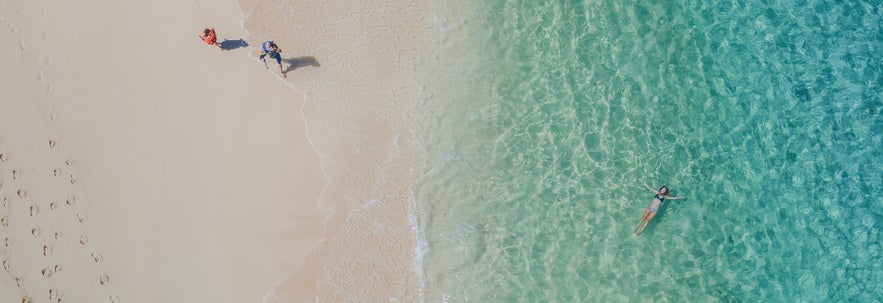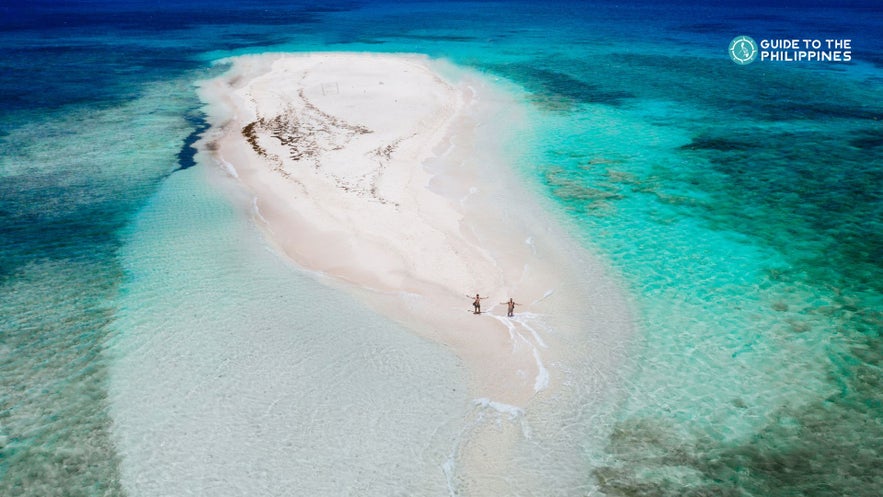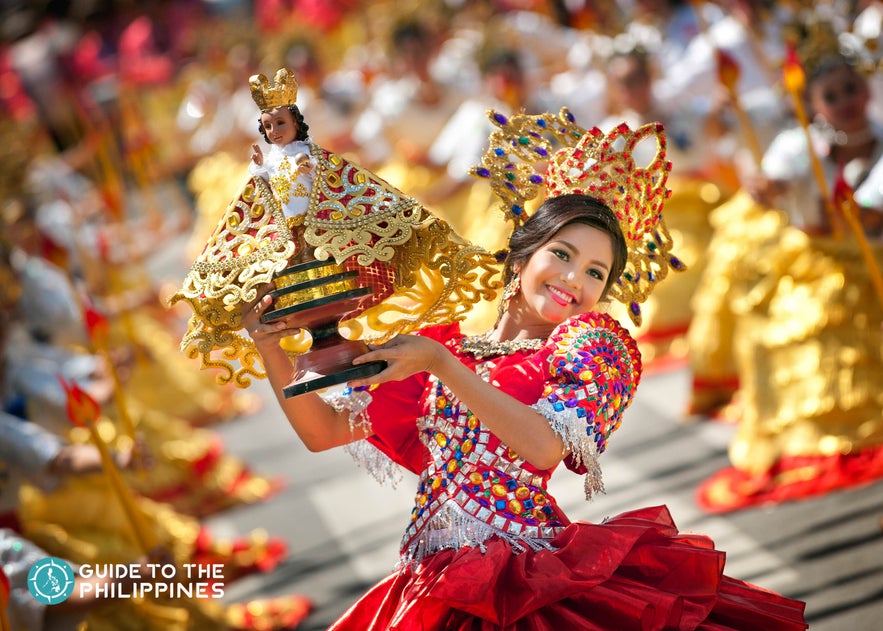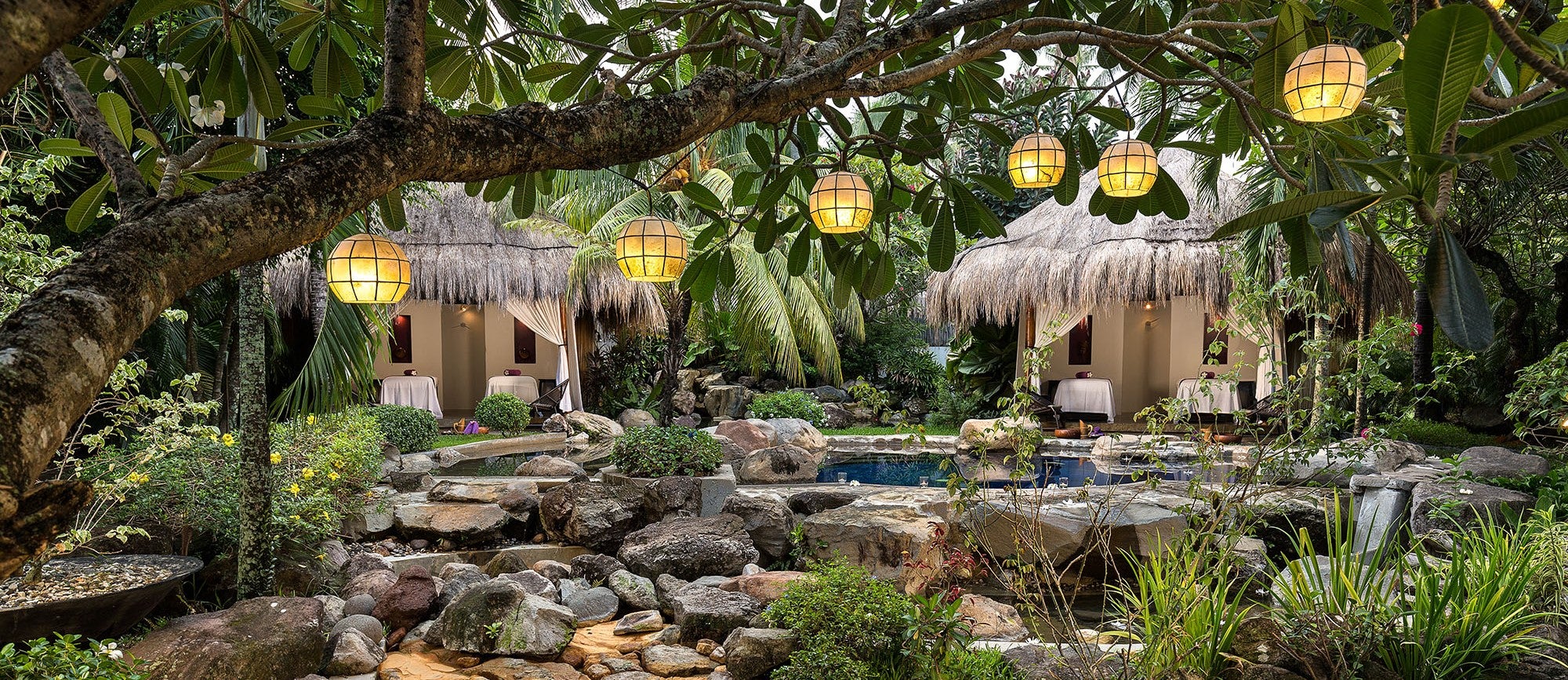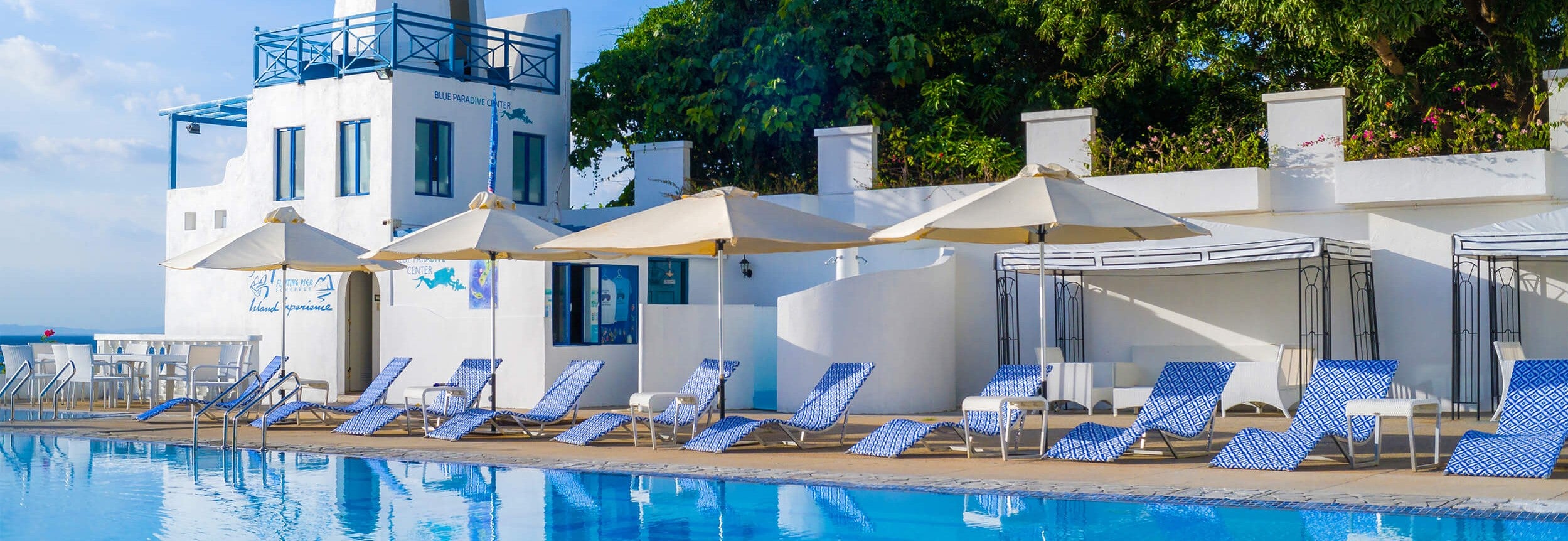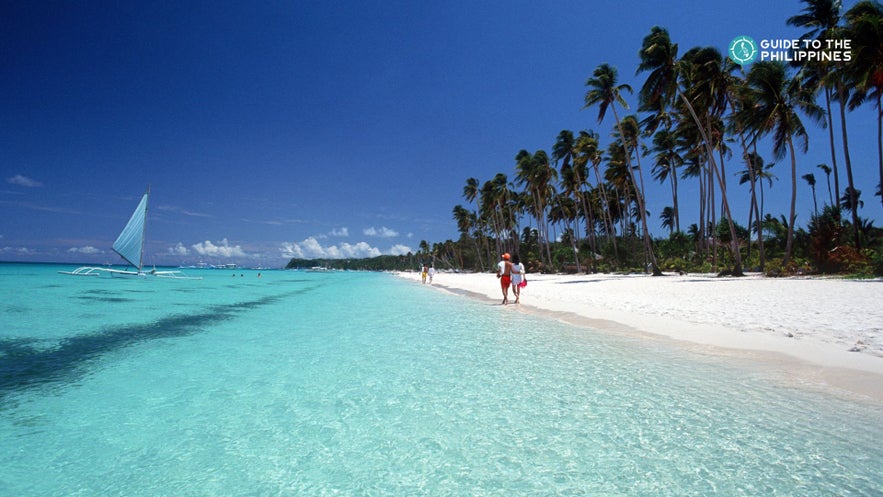
White Beach in Boracay Island, Philippines
The Philippines, an archipelago of over 7,000 islands, is brimming with natural beauty, rich culture, and adventure. With a wealth of destinations to explore, from tranquil beaches to mountain trails and historic sites, there’s something for every type of traveler.
The Philippines is home to some of the most stunning beaches in the world. Must-visit spots like Boracay Island’s famous White Beach and the limestone cliffs of El Nido and Coron towns in Palawan Island are perfect for relaxation and exploration alike.
Travelers in the Philippines can embark on exciting adventures like island hopping, snorkeling, diving, and even sunset cruises. With a variety of beach types—white sands, volcanic black shores, and even pink sands—each destination has its own unique appeal.
Beyond the coastline, the Philippines offers inland attractions that showcase its rich landscapes and history. In Luzon region, the UNESCO-listed Banaue Rice Terraces reveal the country’s agricultural heritage, while the historical walled city of Intramuros in Manila City, the country capital, provides a window into the Spanish colonial era.
For nature enthusiasts, the Cordillera mountains offer incredible hiking trails, and Kawasan Falls in Cebu Island Province is a must-see with its turquoise cascades. These experiences go beyond the beach, letting you see a more nuanced side of the Philippines.
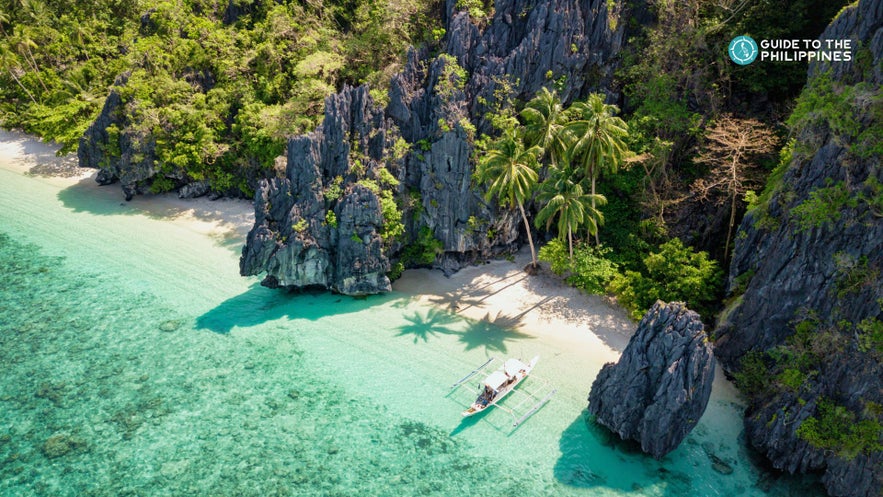
Entalula Island in the town of El Nido, Palawan
To make the most of your time, consider choosing from a range of vacation packages designed to cover highlights across the islands, including convenient transfers, accommodations, and guided tours.
The best tour packages in the Philippines often focus on popular routes, like traveling between the neighboring islands of Cebu and Bohol or exploring the most popular Palawan island-hopping circuits, allowing you to visit multiple destinations with ease. Whether you’re traveling solo, with family, or as part of a group, these packages provide a streamlined approach to exploring the country’s top spots.
To fully immerse yourself in Filipino culture, explore the local food scene and attend a festival. Filipino cuisine is rich and diverse, featuring iconic dishes like adobo, lechon, and adventurous flavors such as tamilok (woodworm) and balut (fertilized duck egg).
Festivals in the Philippines, like Cebu Island’s Sinulog or Baguio City’s Panagbenga, provide an opportunity to experience traditional music, dance, and colorful celebrations.
With its top places to visit, exciting activities, and a variety of travel options, the Philippines promises an enriching experience for all. This guide will help you navigate the best of what the country has to offer, from beaches and mountains to historic landmarks and vibrant flavors, ensuring a memorable journey in this tropical paradise.
Key Takeaways
-
The Philippines is a tropical archipelago in Southeast Asia made up of over 7,600 islands, known for its white-sand beaches, world-class diving, lush mountains, and friendly locals.
-
Top destinations include Palawan Island (El Nido and Coron Towns), Boracay Island, Cebu Island, Siargao Island, and Bohol Island, each offering a unique mix of nature, culture, and adventure.
-
The best time to visit the Philippines is during the dry season, from December to May, when the weather is ideal for beach trips, island hopping, and sightseeing.
-
International airports in Manila, Cebu, and Clark Cities serve as major gateways, with easy connections to popular island destinations via domestic flights and ferries.
-
English is widely spoken across the country, and Filipino hospitality makes it easy for visitors to navigate and feel welcome.
-
Popular activities include island hopping, scuba diving, surfing, trekking, food tours, and cultural experiences, making the country ideal for all types of travelers—from solo backpackers to honeymooners and families.
-
The currency in the country is the Philippine Peso (PHP), and both cash and cards are accepted, though smaller islands and remote areas are typically cash-based.
-
You can book tours, transportation, and pre-arranged vacation packages through Guide to the Philippines, ensuring a smooth and hassle-free travel experience.
Best Time to Go to the Philippines
Naked Island in Siargao
The Philippines experiences two main seasons: dry and wet. The dry season, which runs from November to June, is considered the ideal time to visit, as the weather is generally sunny and perfect for beach trips, island-hopping, and outdoor adventures across the country.
The wet season spans July to October, when the country receives an average of nine typhoons. These can bring heavy rains, occasionally causing flooding or landslides, especially in more remote areas. While not all typhoons make landfall, rainy weather during this season may still impact travel plans, so it's wise to monitor forecasts before and during your trip.
However, rain doesn’t fall consistently every day or throughout the day during the wet season unless a typhoon is passing through. For a smoother experience, check the weather forecasts for your planned destinations before setting off. Here’s an overview of what to expect across the Philippines during each season to help you plan the best time for your visit to the Philippines.
January to March |Perfect Months to Explore the Philippines
Sinulog Festival in Cebu City, Philippines
January to March is one of the best times to travel in the Philippines, with cooler temperatures and minimal rainfall. This period is also packed with vibrant festivals and holidays, making it an ideal time to experience Filipino culture and celebrations.
March marks the beginning of the festive season, as well as the long Holy Week (Easter) holiday, drawing visitors from all over.
During these months, several grand festivities are celebrated across the country:
-
In the second week of January, Aklan province celebrates the Ati-Atihan Festival with lively street dancing, music, and colorful costumes. This festival, held in the province that’s also home to Boracay Island, draws visitors looking to immerse themselves in local heritage. Pairing the festival with a trip to enjoy Boracay Island’s fun activities and breathtaking beaches makes for an unforgettable cultural and tropical getaway.
-
Cebu Island’s Sinulog Festival, held every third Sunday of January, is one of the Philippines’ largest and most anticipated events. The streets come alive with parades, dances, and a vibrant energy that showcases Cebu Island’s rich traditions. Visitors can enjoy the festivities alongside exploring Cebu Island’s popular attractions for a well-rounded experience.
-
Every January 9, millions gather in the district of Quiapo in Manila City, for the Feast of the Black Nazarene, a grand procession that highlights the country’s deep religious roots. It’s a unique cultural experience that attracts both locals and travelers.
-
The spectacular Philippine International Hot Air Balloon Festival, held in February or March, showcases hot air balloons and aerial displays. It’s a visual treat for visitors and a great addition to any itinerary during this period.
-
The Panagbenga Festival, or Flower Festival, transforms the Summer Capital of the Philippines, Baguio City, into a floral wonderland every February. Parades of flower-adorned floats celebrate Baguio’s blooms, and visitors can enjoy the festivities with the cool climate as well as explore Baguio City’s scenic spots.
-
In late March or early April, Holy Week (Easter) observances are held throughout the country. Pampanga province and the Moriones Festival in Marinduque Island, in particular, are known for their unique and solemn processions, providing visitors with insightful cultural experiences.
April to June | Summer and Peak Season in the Philippines

White sand beach in Cebu Island Province
From April to June, the Philippines experiences its hottest and most humid months, marking the height of the summer season. During this time, locals flock to beaches or travel back to their hometowns for vacations, making it a peak travel period. Beach resorts are often fully booked, with higher rates due to increased demand.
With the sun at its strongest, it’s essential to take precautions when spending extended time outdoors. Remember to apply sunblock regularly to protect your skin from sunburn, especially during midday hours.
Popular summer destinations in the Philippines include:
-
Palawan Island’s natural wonders, featuring stunning hidden gems and scenic landscapes. Discover top Palawan Island activities to make the most of this paradise.
-
Boracay Island’s white beaches and clear waters are perfect for beach lounging, adrenaline-packed water sports, and island hopping adventures.
-
Batangas province’ beaches and dive spots, especially popular for its diverse marine life in Anilao. Dive into Batangas province escapades for beach and underwater experiences near Manila City.
Beyond beaches and island hopping trips in the Philippines, April to June also brings vibrant festivals and unique experiences across the country:
-
Bangus Festival in Dagupan City, celebrated every April, showcases the region’s finest milkfish.
-
Pahiyas Festival in Quezon Province on May 15th is a colorful thanksgiving celebration with decorative displays of local produce.
-
Flores de Mayo, celebrated in May, features beautiful parades of elegantly dressed women honoring the Virgin Mary.
-
Town fiestas in the provinces of Batangas and Bulacan offer local food, music, and dancing, bringing each town’s community together in celebration.
-
June also brings the Pintados-Kasadyaan Festival in Tacloban City, featuring a sailboat race, the Subiran Regatta, and the Balyuan religious rite.
-
The month wraps up with St. John the Baptist’s Feast Day on June 24, also known as the Wattah Wattah or Basaan Festival, where locals engage in playful water splashing, celebrated in provinces like Batangas, Bataan, and Nueva Ecija.
July to October | Rainy and Off-Peak Season in the Philippines
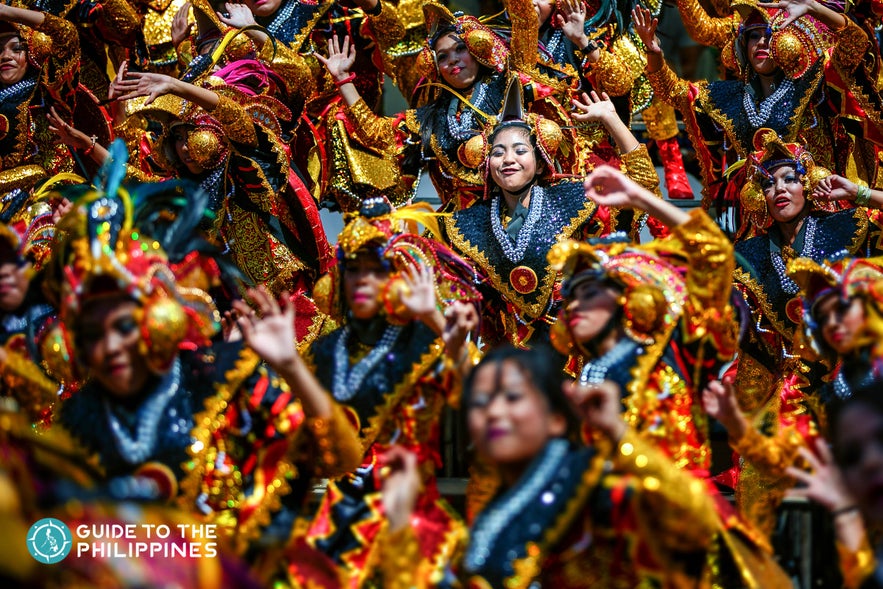
Kadayawan Festival in Davao City, Philippines
From July to October, the Philippines enters its rainy season, with July and August typically bringing the heaviest rainfall. Although showers are frequent, they don’t necessarily last all day. However, when typhoons occur, they can impact large areas of the country, causing travel delays and occasionally flight cancellations, depending on where the typhoon lands.
This off-peak season is ideal for budget travelers, as flights to many islands and beach resorts are more affordable. While beach trips are still possible on clear days, this time of year is also perfect for food tours, museum visits, and cultural experiences. Here are some unique activities and festivals to enjoy during the rainy season:
-
Visit the top surfing spots in the Philippines: La Union province, Baler province, Zambales province, and Siargao Island are ideal for those seeking waves and coastal adventure.
-
Held in July, the Sandugo Festival in Bohol Island commemorates the historic blood compact between Datu Sikatuna and Spanish explorer Miguel López de Legazpi. If you're not visiting during the festival, you can learn about this historical event at the Blood Compact Shrine which is usually included in Bohol Island tours.
-
In August, Davao City comes alive with Kadayawan Festival's street parades, traditional dances, and floral displays celebrating the region’s bountiful harvest and cultural heritage. Must-try Davao City activities can enhance your visit to this festive city.
-
Peñafrancia Fluvial Parade in Naga City is a religious event held in September features a grand river procession in honor of Nuestra Señora de Peñafrancia, the patroness of the Bicol region.
-
MassKara Festival, known as the “Festival of Smiles,” is an October event in Bacolod City that fills the streets with vibrant masks, elaborate costumes, and upbeat street dances.
As early as September, the Philippines begins to prepare for the Christmas season. Known for its extended holiday celebrations, the country sees shops and establishments decked out in festive decorations, marking the start of the "ber months" and building excitement for the upcoming holiday season.
While July to October is considered off-peak, these months offer a unique opportunity to experience Philippine festivals, surfing, and holiday traditions, all with fewer crowds and lower travel costs.
November to December | Holiday Season in the Philippines
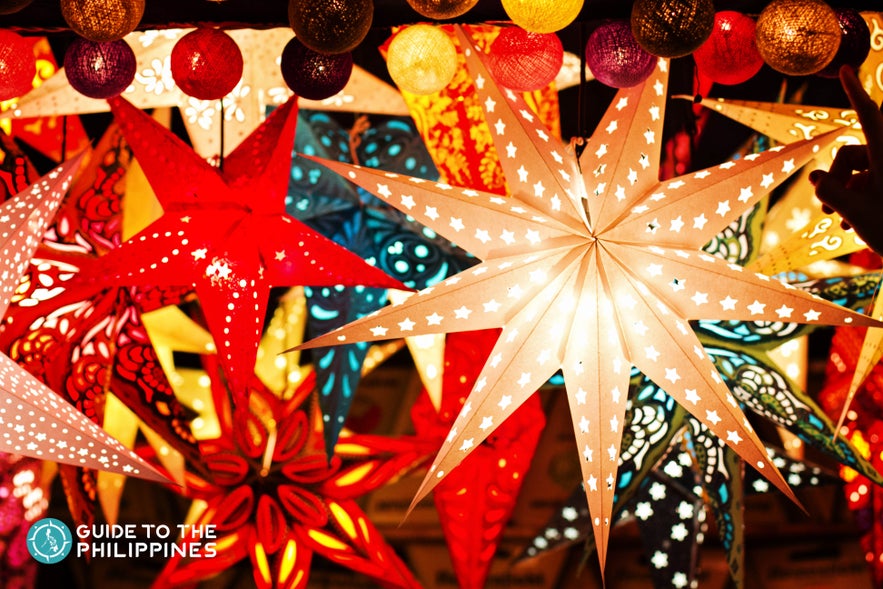
November marks not only the start of the dry season but also the beginning of the festive holiday celebrations across the Philippines. This is a wonderful time to visit cities, where you’ll find lively night markets, dazzling light shows, and Christmas bazaars, adding a magical touch to the streets.
With extended mall hours and seasonal sales, November and December are perfect for holiday shopping. Beyond shopping, there are plenty of unique events and experiences to enjoy:
-
Watch the lively parade of giant paper effigies in Angono town of Rizal Province, showcasing a fun and colorful Filipino tradition.
-
Experience the grand Christmas lantern displays in Pampanga Province's San Fernando City, where enormous, intricately designed lanterns light up the night in stunning displays.
-
Banaue Rice Terraces and Benguet Highlands
Enjoy the cool weather and scenic mountain views in Banaue highlands. Sip a warm cup of local coffee or tea while taking in the breathtaking sight of the Banaue Rice Terraces.
Ultimately, the best time to visit the Philippines depends on your interests and the experiences you seek. Each season offers unique attractions, so visiting at different times will give you a fuller appreciation of all the Philippines has to offer.
Geography of the Philippines
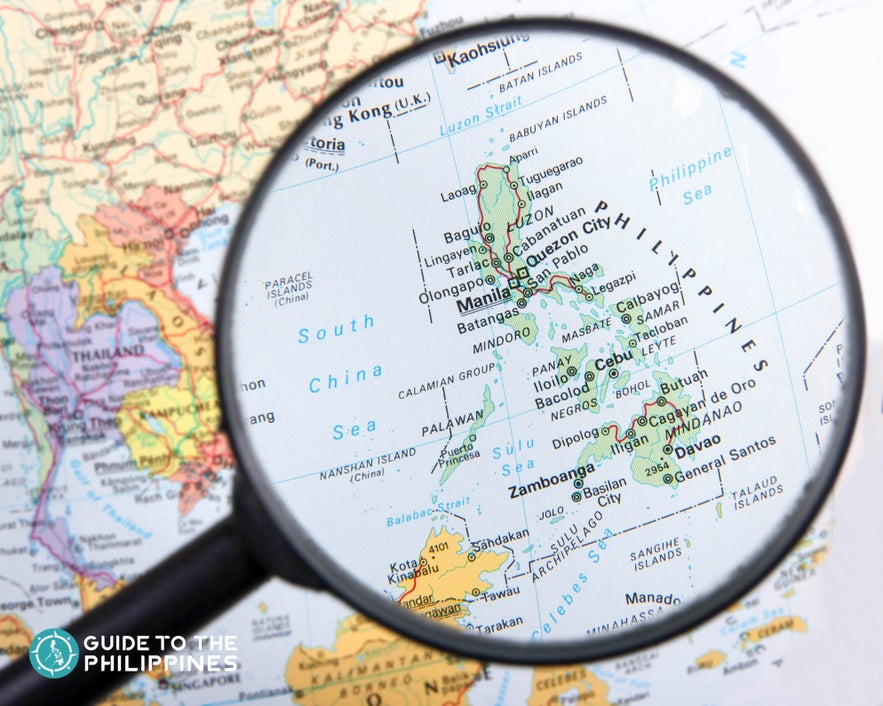
The Philippines is an archipelago divided into three main island groups: Luzon, Visayas, and Mindanao. Understanding the layout of these regions is essential for planning your trip, as your transportation, schedule, and travel budget will vary depending on the distances between destinations.
Luzon Region
Most international travelers will begin their journey in Luzon region, as Manila, the capital city, is the primary entry point to the Philippines. From Manila City, there are convenient flights to other regions across the country.
Luzon also includes popular destinations like Palawan Island, Batanes Island, Baguio City, and Vigan City. Key activities in Luzon range from city sightseeing and historical tours to beach escapes and island-hopping adventures.
Visayas Region
Located in the central part of the Philippines, the Visayas region is easily accessible through Cebu City, the main gateway for travel to nearby islands. Visayas region is home to island destinations like Boracay, Bohol, Iloilo, Negros, Leyte, and Siquijor, which are home to breathtaking attractions. Visitors here can enjoy pristine beaches, vibrant island-hopping tours, outdoor activities, and unique food tours showcasing local flavors.
Mindanao Region
Mindanao region, in the southern Philippines, offers a mix of nature and adventure attractions. Davao City serves as the main gateway, with access to destinations like Siargao and Camiguin Islands, Zamboanga and Cagayan de Oro cities. Highlights in Mindanao include outdoor adventures, beach getaways, and more island-hopping experiences.
With so many incredible activities and sights, it’s easy to fill an itinerary with memorable experiences. Whether you have a week or more, the Philippines offers endless possibilities for adventure and relaxation across its diverse island regions.
Arriving at Manila Airport: What You Need to Know
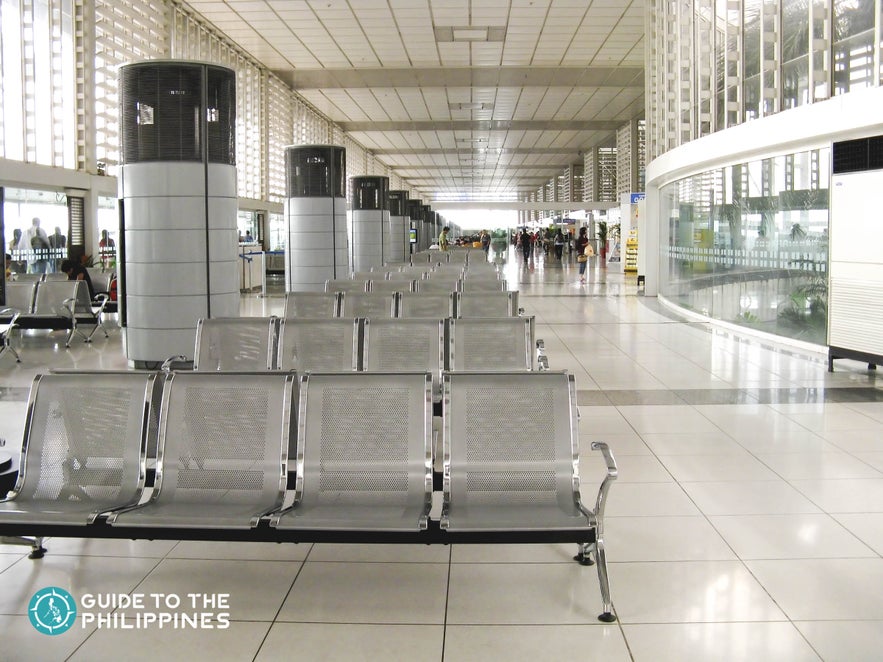
Manila, like many bustling cities, can feel overwhelming for first-time visitors, especially upon arrival at the airport. Officially known as Ninoy Aquino International Airport (NAIA), Manila Airport has four separate terminals, which are not linked by a rail system. This makes it essential to check your terminal when booking flights in the Philippines, as inter-terminal transfers require time and planning.
Fortunately, Point-to-Point (P2P) shuttle buses and airport transfers are available for traveling between the terminal and your hotel, along with other options like taxis and Grab (similar to Uber) for easy commuting. Car rentals are also available for those who prefer added convenience. Since these transport options use public roads, it’s wise to allow extra time for terminal transfers. Here’s a quick overview of Manila City’s airport terminals:
NAIA Terminal 1
Terminal 1 serves many international flights arriving in and departing from Manila City, except those operated by airlines assigned to Terminals 2 and 3.
NAIA Terminal 2
This terminal, also known as the Centennial Terminal, serves both domestic and international flights of Philippine Airlines and its affiliate PAL Express. Since July 2023, AirAsia and Royal Air domestic flights have also been moved to Terminal 2. Starting November 7, 2024, domestic flights of Cebu Pacific has also been moved to Terminal 2 from Terminal 4.
NAIA Terminal 3
Terminal 3 handles international flights operated by airlines such as Cathay Pacific, AirAsia, Emirates, Cebu Pacific, KLM, Delta, All Nippon Airways, and Singapore Airlines. It also accommodates select domestic Cebu Pacific flights.
NAIA Terminal 4
The smallest of the four, Terminal 4 is dedicated to domestic flights. However, starting November 6, 2024, Terminal 4 has been closed for renovation and is expected to reopen in February 2025.
Clark International Airport: Secondary International Gateway near Manila City
Clark International Airport, located 93 kilometers north of Manila City, serves as a convenient secondary international airport. Travel time from Manila City to Clark City in Pampanga Province is approximately two to three hours, depending on traffic.
For a convenient transfer, travelers can use the Premium Point-to-Point (P2P) Bus Service. This bus operates from NAIA Terminal 3 in Pasay City, a suitable option for those coming from the southern part of Metro Manila region. If you're traveling from the north, you can catch the P2P bus at the North EDSA MRT/Trinoma Station in Quezon City.
For a more comfortable and private option, consider hiring a car rental from Clark City to Manila City. Just be sure to have the necessary requirements for renting a car in the Philippines.
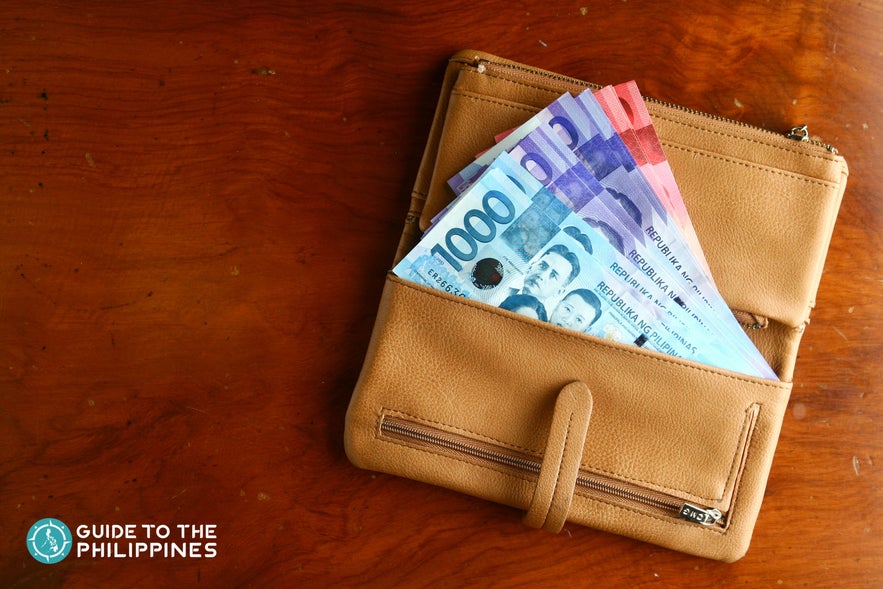
Currency Exchange and ATMs
Each airport terminal offers 24/7 money changers available in both arrival and departure areas. ATMs that accept foreign-issued cards are also accessible, though keep in mind that transaction fees may apply. For more details, refer to this comprehensive guide on money exchange in the Philippines.
Source: https://currencyrate.today/converter-widget
Transportation to and from Manila airports
Each Manila airport terminal has taxi stands with two main options: coupon taxis (white), dispatched by airport personnel and charged at a fixed rate, or yellow metered taxis. While both options are slightly more expensive than regular white taxis, they are generally safer for airport transfers.
Shuttle buses are also available, connecting you to the nearest metro station; however, for first-time visitors, these can be less comfortable than other options. For added convenience, consider booking an airport taxi, hiring a car rental, or carpooling through the Grab App. If you're traveling with a large group or heavy luggage, a van rental or budget car rental in the Philippines may be more suitable.
For a smooth arrival or departure experience, explore Manila airport transfer services for a hassle-free journey.
How to Get Around the Philippines
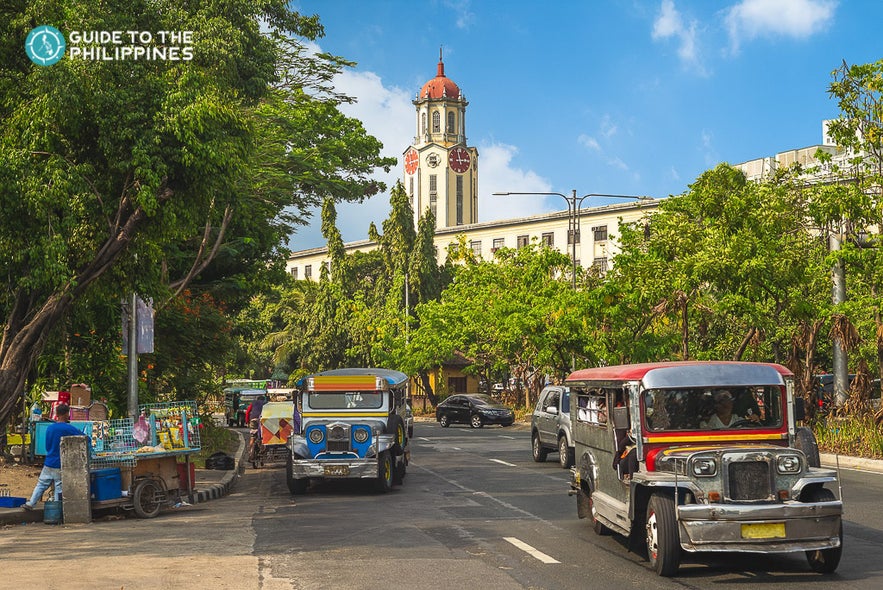
Jeepneys in Manila City, Philippines
Traveling within the Philippines often involves buses, flights, and sea transfers. For short inter-island trips, ferries are ideal, but flights are recommended for longer distances. Depending on the season, there are plenty of affordable flights across the country, sometimes even cheaper than ferries. The main carriers are Philippine Airlines, Cebu Pacific, and AirAsia. Read this guide on how you can find the cheapest flights in the Philippines.
In towns and cities, common modes of transport include buses, jeepneys, and tricycles—smaller, motorized vehicles similar to Thailand’s tuk-tuks. Major cities also offer taxis and the Grab app, while Manila is currently the only city with a metro system. For a more convenient or stylish journey, consider renting an SUV or a luxury car. Read this article on the best cars to rent for a road trip in the Philippines to help you choose which vehicle is perfect for your trip.
For inter-island travel, ferries are the best choice. To make your journey smoother, book your Philippines ferry tickets in advance.
Hotels and Resorts in the Philippines

Stilt cottages at Pearl Farm Beach Resort in Samal Island of Davao, Philippines
The Philippines has a wide range of accommodations to suit every traveler, from luxury stays to budget-friendly options. In cities like Manila, you’ll find everything from high-end Manila City hotels to budget hotels and hostels, catering to both business and leisure travelers. For added convenience, there are also hotels near Manila Airport for easy access to flights.
In top island destinations, resorts in the Philippines are a favorite choice. Boracay Island resorts offer beachfront access and a lively atmosphere, while Palawan Island resorts provide a more secluded experience, surrounded by stunning natural landscapes.
For a tranquil island getaway, Bohol Island resorts offer peaceful settings and are close to unique attractions like the Chocolate Hills and premier diving spots. Cebu City hotels provide both urban comforts and coastal getaways, making it easy to enjoy Cebu’s blend of city life and beach relaxation.
Budget travelers will be pleased to know that many of these popular destinations also offer budget hotels, hostels, and guesthouses. These options make it possible to experience the beauty and culture of the Philippines without breaking the bank.
Whether you’re looking for a luxury beachfront villa, a cozy family-friendly stay, or a budget hostel close to the action, hotels in the Philippines offer a variety of choices to meet your travel needs. Booking in advance is advisable, particularly during peak seasons in top destinations to secure your preferred accommodation.
Must-Visit Destinations in the Philippines
With over 7,000 islands, the Philippines offers an abundance of stunning destinations that are sure to make your itinerary unforgettable. Depending on your time and interests, you can explore everything from historic cities and pristine beaches to breathtaking mountains and unique wildlife encounters. Here’s a guide to some of the must-visit destinations in the Philippines that showcase the best of the country’s diverse beauty and culture:
Manila City: The Capital of the Philippines
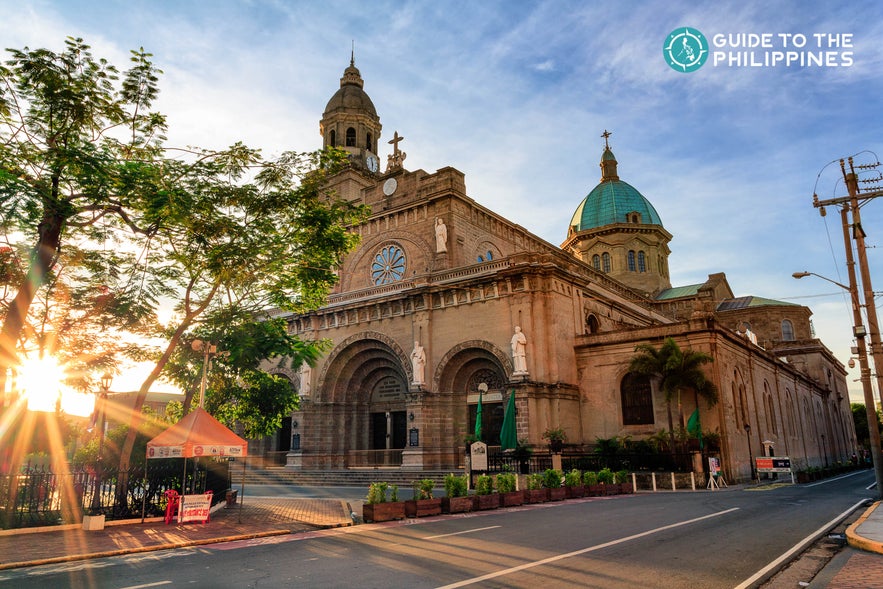
Manila Cathedral inside the walled city of Intramuros
While many travelers use Manila as a transit point, the city itself offers a range of cultural and historical attractions worth exploring. Start with the walled city of Intramuros, a Spanish-era fortress that transports you back to colonial times with cobblestone streets, beautiful churches, and heritage structures.
Intramuros tours include visits to San Agustin Church, built in 1587, and Manila Cathedral, both testaments to the city's rich history.
- Browse top-rated Manila City activities that you can add to your itinerary
Beyond Intramuros, visit Binondo, the world’s oldest Chinatown, where you can sample unique Filipino-Chinese dishes. When it comes to accommodations, aside from staying in Manila City hotels, staying in centrally-located Makati City hotels or top-rated Bonifacio Global City (BGC) hotels offers a mix of luxury, shopping, and nightlife for a convenient stay.
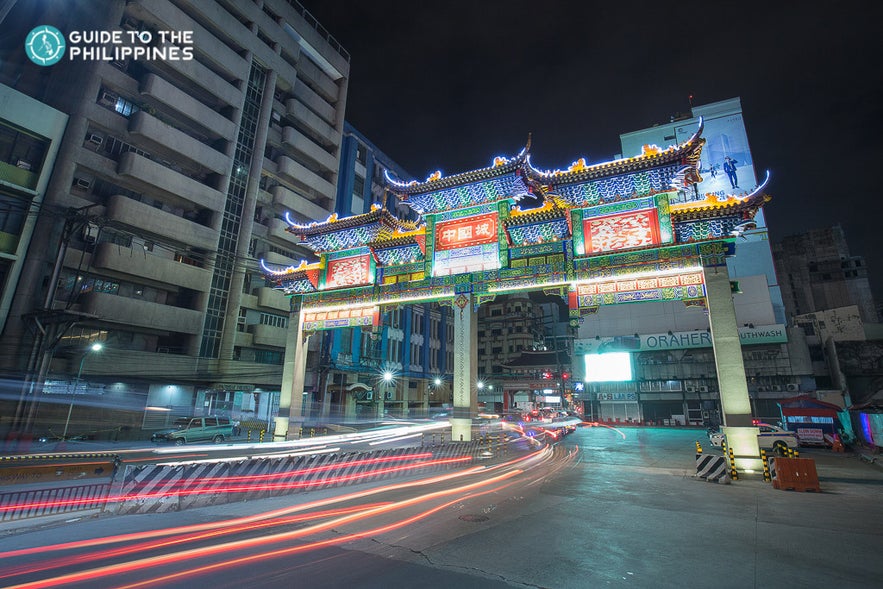
Binondo Chinatown in Manila City
Check out vacation packages in Manila with pre-arranged hotels, transfers, and tours for a hassle-free way to explore the city’s highlights.
Palawan: Gateway to the Best Islands in the Philippines
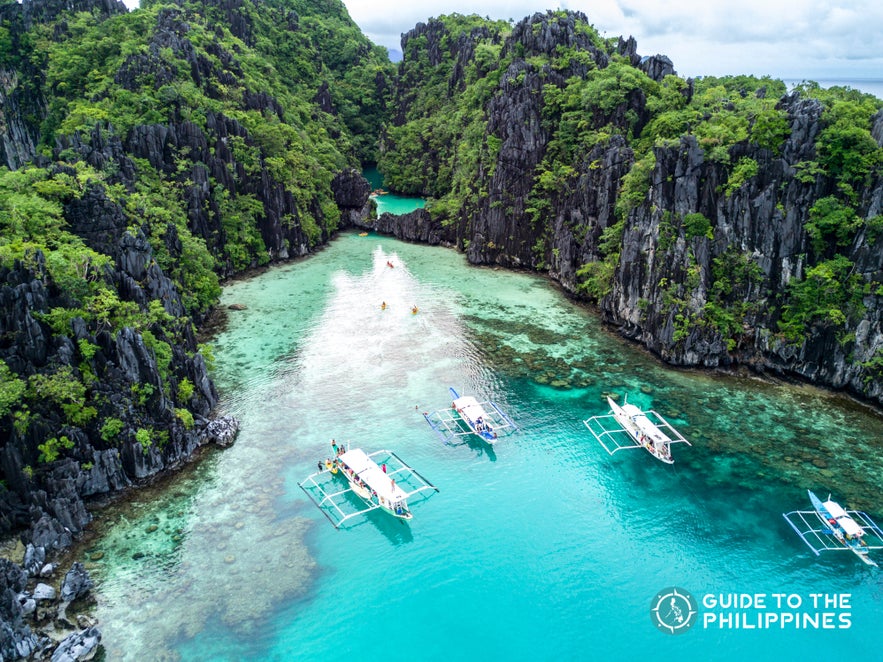
Small Lagoon in El Nido, Palawan
Named one of the world’s most beautiful islands, Palawan is a paradise that’s home to spectacular natural attractions. Start your Palawan Island adventures in the capital, Puerto Princesa City, where you can visit the Underground River, one of the UNESCO World Heritage Sites in the Philippines. This river cave system is awe-inspiring and accessible by a guided boat tour.
Puerto Princesa City is also the gateway to Honda Bay island hopping, a perfect way to discover some of Palawan Island’s best beaches and marine biodiversity.
Another gem in Palawan Island is the town of El Nido, known for its stunning archipelagos and turquoise lagoons surrounded by majestic limestone cliffs. Joining El Nido island-hopping tours will let you explore the town's best attractions like hidden beaches, secluded coves, and crystal-clear waters.
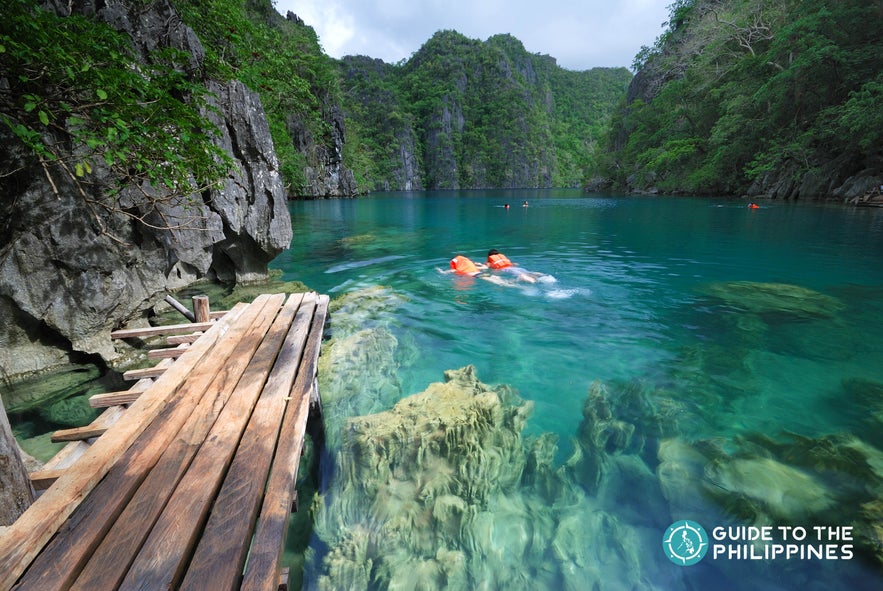
Kayangan Lake in Coron, Palawan
Further north, Coron town is a mecca for divers and nature enthusiasts alike. Famous for its breathtaking tourist spots like pristine lagoons, limestone cliffs, and the stunning Kayangan Lake, Coron town is also one of the world’s top destinations for wreck diving. Discover top-rated tour packages to Coron town that include the best hotels, airport transfers, and exciting island hopping and nature sightseeing activities.
Explore our vacation packages to Palawan Island to experience the best of Puerto Princesa City and the towns of Coron and El Nido.
Boracay Island: White Beach Paradise

Boracay Island's White Beach
Renowned for its powdery white sands, crystal-clear waters, and vibrant nightlife, Boracay Island is a tropical paradise that attracts visitors from around the world. The famous White Beach is the island's claim to fame, often hailed as one of the best beaches in the Philippines, and for good reason.
With its powdery, white sand that feels like silk underfoot and crystal-clear turquoise waters, White Beach creates the ultimate paradise setting that rivals the world’s finest shores.
Boracay Island’s must-try activities are endless, catering to thrill-seekers, beach enthusiasts, and families alike. Feel the rush of parasailing, try paddleboarding in the calm waters, or dive into the colorful underwater world while helmet diving.
- Browse the largest section of tour packages to Boracay Island to explore this paradise hassle-free.
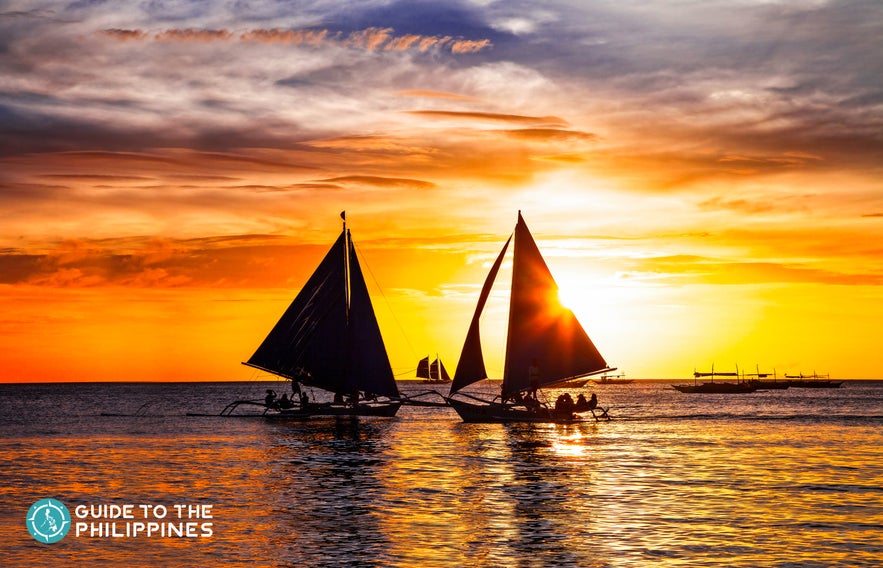
Sunset paraw sailing in Boracay Island
For those looking for a touch of romance, a sunset cruise offers breathtaking views of the sky as it transforms from golden hues to fiery reds, creating a magical end to any day. And if you’re up for something unique, head over to Bulabog Beach—a kitesurfing hotspot where strong winds and expert instructors make it a perfect place to try this exciting sport.
With so many attractions to explore, plenty of must-visit restaurants featuring local cuisine and fresh seafood, and top-rated hotels that line up the pristine white sand beach, Boracay Island is the ultimate destination for those who want a mix of adventure, relaxation, and luxury.
Cebu Island Province: Blend of Beaches, History, and Adventure
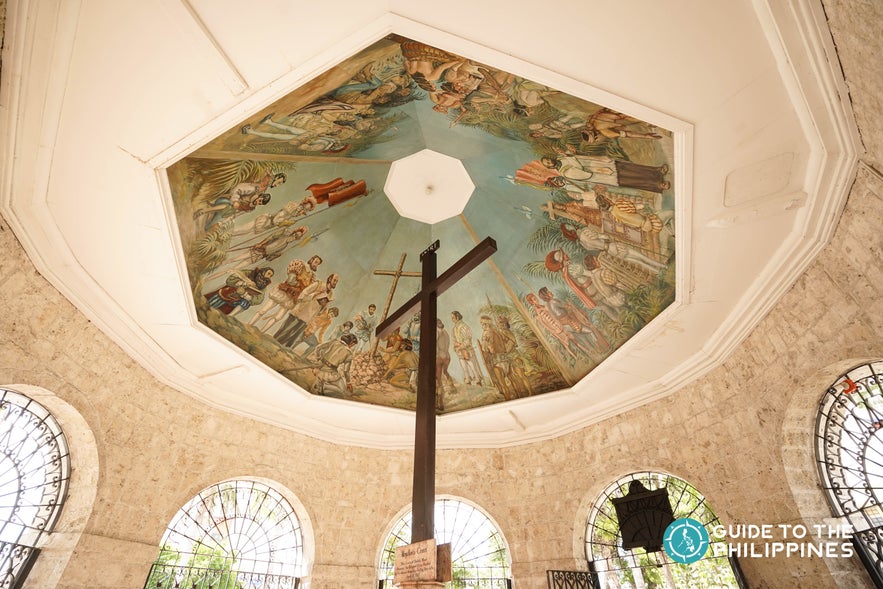
Magellan's Cross in Cebu City
Cebu is an island province that truly has it all—rich in cultural heritage, filled with natural beauty, and brimming with thrilling activities. In the capital Cebu City, you can explore historical landmarks such as Magellan’s Cross and the Basilica del Santo Niño, giving you a taste of the country’s Spanish colonial past.
Beyond the city, Cebu Island’s diverse landscapes are a must-visit. In the north, islands like Malapascua and Bantayan are known for their stunning beaches and vibrant marine life. Malapascua Island is especially famous for its thresher shark dives, the only place in the world where you can see these unique sharks daily.
Bantayan Island, on the other hand, offers pristine beaches perfect for relaxing and snorkeling, making it a favorite for beach lovers.
Heading south, you’ll find some of Cebu Island’s most exciting adventures. In the town of Oslob, you can swim alongside the majestic whale sharks, a truly unforgettable experience that brings you up close to these gentle giants. Just a short distance away, you can visit the Sumilon Island sandbar, which offers crystal-clear waters and fine white sands. As the sandbar emerges with the tides, it’s an ideal spot for beach lounging and snorkeling in a picture-perfect setting.
For more underwater adventures, Moalboal town offers the famous sardine run experience, where you can snorkel or dive among massive schools of sardines—a mesmerizing sight unique to this area. For thrill-seekers, canyoneering at Kawasan Falls is a must, with a combination of trekking, swimming, and cliff-jumping into turquoise pools.
Nature enthusiasts will enjoy the scenic views from Osmeña Peak and the refreshing waters of Tumalog Falls, as well as serene beach spots like Lambug and Basdaku Beach.
With so much to see and do, booking pre-arranged tour packages to Cebu Island makes it easy to experience the best of this destination, from historical tours in Cebu City to breathtaking adventures in its north and south regions. Whether it’s whale shark encounters, picturesque sandbars, or thrilling canyoneering, Cebu Island promises a Philippine adventure like no other.
Bohol Island: Countryside Sightseeing, Beaches and Diving Spots
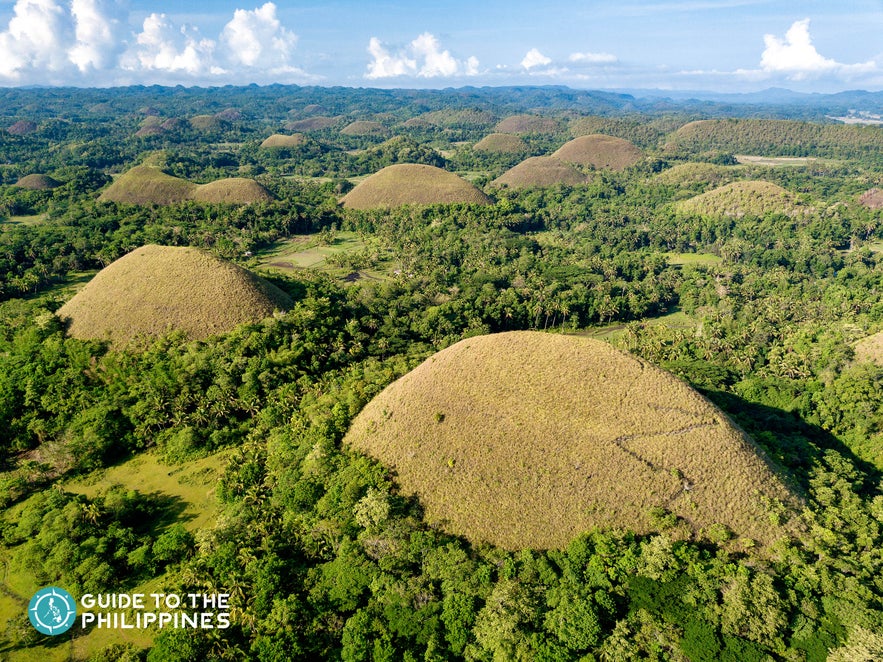
Chocolate Hills in Bohol Island
Bohol Island is a perfect destination for travelers seeking both natural wonders and vibrant coastal scenes. One of its most popular attractions are the Chocolate Hills, a remarkable landscape of rolling, chocolate-colored mounds during the dry season.
Another highlight of tours in Bohol Island is the Loboc River Cruise, where you can relax on a riverboat while savoring a Filipino buffet and enjoying live music by local performers. This scenic cruise through the lush landscapes of the Loboc River is a relaxing and culturally immersive experience that showcases the natural beauty of Bohol Island’s interior.
Bohol Island is also famous for its unique wildlife. At a tarsier sanctuary, you can observe the Philippine tarsier, a small primate known for its large eyes and endearing expressions. These sanctuaries provide a safe habitat for these adorable creatures, allowing visitors to see them up close in a protected environment.
For those who love the beach, Alona Beach is a lively spot where you’ll find beachfront restaurants, bars, and a vibrant nightlife scene. It’s the perfect place to unwind by the sea with local cuisine and enjoy the island’s laid-back yet lively atmosphere.
Meanwhile, Balicasag Island is just a boat ride away through Bohol island hopping tours and is renowned for its exceptional snorkeling and diving sites. This island is surrounded by coral reefs teeming with marine life, including colorful fish, sea turtles, and other underwater wonders, making it a top choice for diving in Bohol Island.
Browse the largest selection of vacation packages to Bohol Island, which lets you easily enjoy the best of this top destination in the Philippines—exploring the serene countryside, immersing in local culture, and diving into vibrant coastal adventures. Bohol Island truly offers a balanced and unforgettable experience for every kind of traveler.
What to Eat in the Philippines
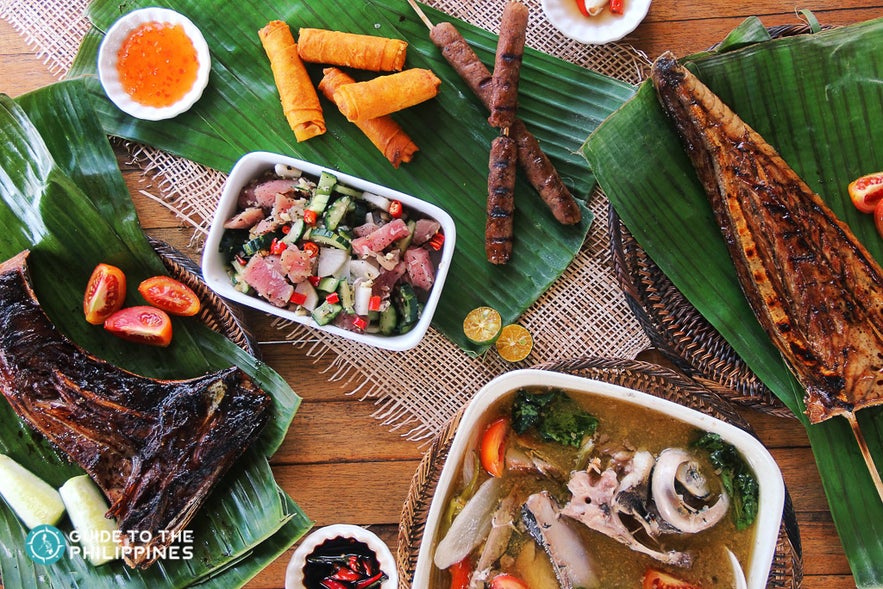
Filipino cuisine is often underrated on the global stage, but it holds a unique charm and flavor profile that reflects the country's rich history and cultural diversity. With influences from Spanish, Chinese, American, and indigenous cooking traditions, Filipino food is flavorful, hearty, and often meat-heavy.
Vegetarians and vegans may find fewer options outside major cities, but there’s still plenty to explore. Here’s a guide to some of the must-try dishes that highlight the country’s vibrant culinary culture and shouldn't be missed in food tours when in the Philippines.
1. Adobo
 Adobo is a beloved Filipino dish that involves marinating meat or seafood in vinegar, soy sauce, garlic, and black pepper, then simmering it until tender. Each region in the Philippines has its own variation, but the base flavors remain the same. Adobo is often considered the country’s unofficial national dish due to its popularity and versatility.
Adobo is a beloved Filipino dish that involves marinating meat or seafood in vinegar, soy sauce, garlic, and black pepper, then simmering it until tender. Each region in the Philippines has its own variation, but the base flavors remain the same. Adobo is often considered the country’s unofficial national dish due to its popularity and versatility.
2. Sisig
Originating from Pampanga Province, the Philippines' culinary capital, sisig is a sizzling dish traditionally made with chopped parts of a pig’s head and liver, seasoned with onions, chili peppers, and calamansi (Filipino lime). It’s typically served on a hot plate and is popular as a pulutan or bar snack to accompany local beer. Variants of sisig now include tuna, squid, and even mushroom or tofu for vegetarians.
3. Lechon
 Lechon, a whole suckling pig slow-roasted over charcoal, is a centerpiece of Filipino feasts and celebrations. The result is tender, flavorful meat with irresistibly crispy skin. Cebu Province is particularly famous for its lechon, which many Filipinos and tourists regard as the best in the country.
Lechon, a whole suckling pig slow-roasted over charcoal, is a centerpiece of Filipino feasts and celebrations. The result is tender, flavorful meat with irresistibly crispy skin. Cebu Province is particularly famous for its lechon, which many Filipinos and tourists regard as the best in the country.
4. Sinigang
Sinigang is a sour soup that’s a staple comfort food in the Philippines, often made with pork or shrimp. Its tangy broth is typically flavored with tamarind, though other fruits like green mango or guava can also be used to give the soup its distinctive sour taste. Sinigang is loved for its balance of savory and sour flavors.
5. Caldereta
Caldereta is a savory Filipino stew, traditionally made with goat but often prepared with beef or chicken. It’s slow-cooked in a rich tomato-based sauce with bell peppers, potatoes, and liver spread for extra flavor. Cheese is sometimes added to enhance its richness. The dish’s name comes from the Spanish word "caldera," meaning cauldron.
6. Crispy Pata
Crispy pata is deep-fried pork knuckles that are boiled until tender, then fried until the skin is crispy. This dish is a favorite for family gatherings and pairs well with a dipping sauce made from soy sauce, vinegar, and chili.
7. Chicken Inasal
 Hailing from Bacolod City, chicken inasal is a marinated and grilled chicken dish known for its tangy, savory flavors. Marinated in a mixture of vinegar, calamansi, and annatto oil, this dish is traditionally served with rice and a dipping sauce. Bacolod City is known for having some of the best chicken inasal in the country. That's why a trip to Manokan County, the popular strip of restaurants serving this, is a highlight of tours in Bacolod City.
Hailing from Bacolod City, chicken inasal is a marinated and grilled chicken dish known for its tangy, savory flavors. Marinated in a mixture of vinegar, calamansi, and annatto oil, this dish is traditionally served with rice and a dipping sauce. Bacolod City is known for having some of the best chicken inasal in the country. That's why a trip to Manokan County, the popular strip of restaurants serving this, is a highlight of tours in Bacolod City.
8. Dinuguan
Dinuguan is a unique Filipino dish made with pig’s blood and offal, seasoned with vinegar, garlic, and chili. This dark stew has a rich, savory taste and is often served with steamed rice or puto, a steamed rice cake. While the concept might seem unusual, it’s a much-loved comfort food for many Filipinos.
9. Fish Kinilaw
Kinilaw, often compared to ceviche, is made with raw fish marinated in vinegar and seasoned with ingredients like onions, ginger, chili peppers, and calamansi. Yellowfin tuna, mackerel, and marlin are commonly used, resulting in a fresh, tangy dish perfect for seafood lovers.
10. Halo-Halo
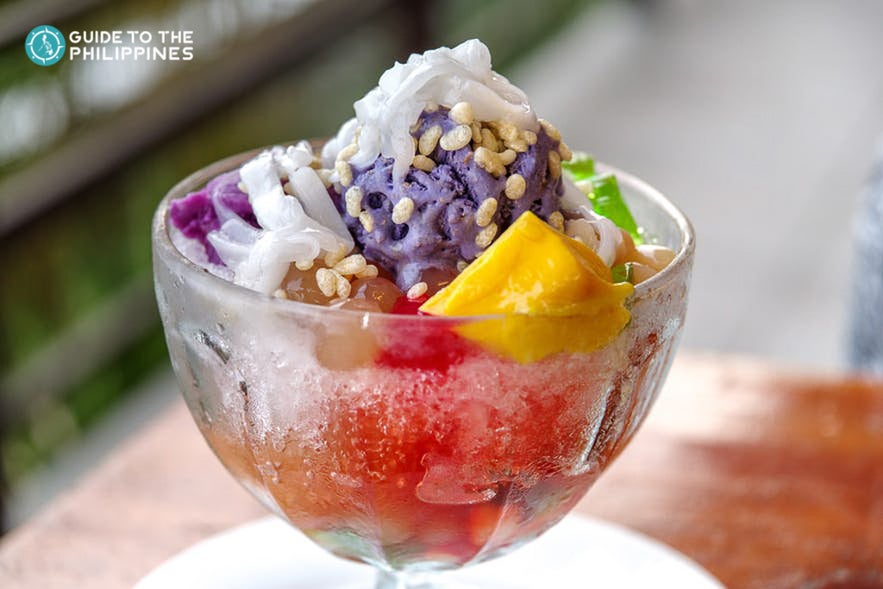
Halo-halo is a popular Filipino dessert or merienda, especially during the hot summer months. It’s a refreshing mix of crushed ice, evaporated milk, and an assortment of toppings like sweet beans, jellies, tapioca pearls, mixed fruits, and even ice cream. Each bite is a delightful surprise, making it a must-try treat in the Philippines.
11. Taho
Taho is a sweet, comforting Filipino street food made from silken tofu, syrup made from caramelized brown sugar, and chewy tapioca pearls. Sold by street vendors who roam the neighborhoods in the morning, you can call them over by shouting "taho!" for a warm, satisfying treat.
12. Balut
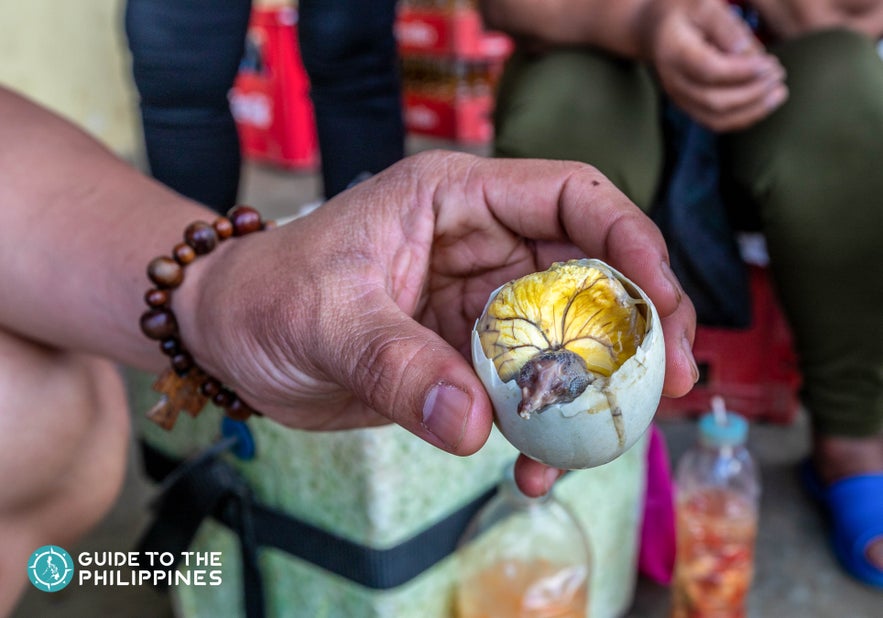
A true Filipino delicacy, balut is a fertilized duck egg that’s been incubated for a couple of weeks before being boiled. Though it may seem adventurous, balut tastes like a regular boiled egg with a bit of added flavor from the broth inside. It’s typically sold in the evening by street vendors calling out "balut!"
Sample 2-Week Itinerary to the Best Beaches & Islands in the Philippines

A well-planned 2-week Philippines itinerary gives you just the right amount of time to experience the country’s most breathtaking beaches and islands. Whether you’re craving powdery white sand, crystal-clear waters, or underwater adventures, two weeks lets you discover the must-sees while still finding time to relax and soak in the tropical charm.
-
Check out the ultimate guide to the best Philippines itineraries to help you plan your perfect trip!
Embark on a 2-week journey to the Philippines’ most stunning beach and island destinations. From Palawan Island’s hidden lagoons and Cebu Island’s marine sanctuaries to Bohol Island’s scenic coasts and the pristine shores of Boracay Island, this adventure covers it all.
Day 1: Manila City
Kick off your adventure in Manila, the Philippines’ dynamic capital city. Known for its blend of Spanish colonial history, modern skyscrapers, and bustling markets, Manila City offers a taste of the country’s vibrant culture and history.
Things to do in Manila City:
-
Explore Intramuros old town: Visit the historic walled city filled with colonial architecture, including Fort Santiago and San Agustin Church.
-
Visit Rizal Park: Relax at this iconic park, a popular leisure spot for locals.
-
Watch the Manila Bay sunset: Head to Roxas Boulevard for a stunning view of the sunset.
-
Go on a Binondo Chinatown food tour: Discover the world’s oldest Chinatown and enjoy authentic Filipino-Chinese cuisine.
Day 2-4: Coron Town on Palawan Island
For Day 2, you will fly to Coron town, a paradise known for its crystal-clear lakes, vibrant coral reefs, and picturesque beaches. This charming town on Palawan Island offers both relaxation and adventure.
On Day 3, you can embark on an island-hopping adventure in Coron town, where you’ll discover some of the most beautiful spots in Palawan Island. From hidden lakes to vibrant marine life, this tour will introduce you to Coron’s natural wonders.
For Day 4, you can spend a day exploring Coron town’s idyllic beaches, each offering a unique experience. These spots are perfect for swimming, snorkeling, or simply soaking up the sun. You can also explore the inland attractions of Coron town after your beach tour.
Things to do in Coron Town:
-
Go on Coron island hopping tours: See Coron town’s exceptional beauty by visiting iconic spots like Kayangan Lake and Barracuda Lake, where you can swim in crystal-clear waters and admire stunning limestone cliffs. Another adventure you can book on a separate day is a tour of the best beaches from Coron town.
-
Visit the top inland attractions of Coron town: You can hike up Mt. Tapyas to take in panoramic views and catch a breathtaking sunset from the summit. Unwind in the natural Maquinit Hot Spring surrounded by lush mangroves, perfect for relaxation after a day of
-
Explore World War II shipwrecks: Dive into history as you discover underwater shipwrecks, remnants of World War II, now home to vibrant coral reefs and marine life.
Day 5-6: El Nido Town on Palawan Island
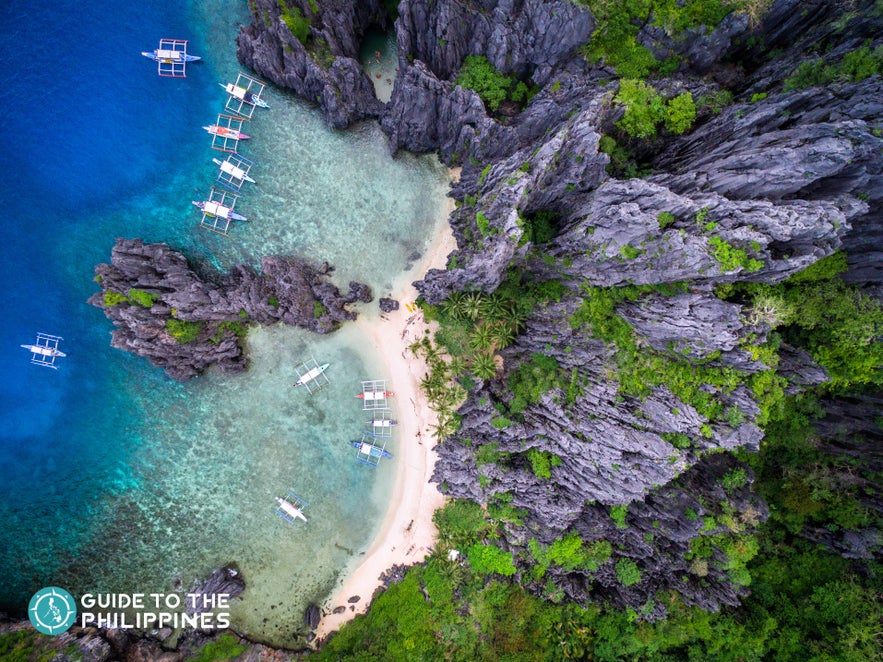
For Day 5, you can take a flight or ride a ferry to the town of El Nido, also located in Palawan Island, and is known for its dramatic limestone cliffs, secluded lagoons, and pristine beaches. This tropical paradise is perfect for nature lovers and those seeking a tranquil getaway.
On Day 6, discover El Nido town’s most famous lagoons and beaches on an island-hopping tour. Known for its stunning scenery, this tour will take you to hidden gems and turquoise waters.
-
Join an El Nido island-hopping tour: Embark on one of the popular island-hopping tour circuits in El Nido town and explore stunning attractions like the iconic Big Lagoon (included in the El Nido Tour A itinerary) with its turquoise waters framed by limestone cliffs.
-
Relax at Nacpan Beach: Lounge on the soft sands of Nacpan Beach, one of El Nido town’s most picturesque spots, perfect for a laid-back day by the sea.
-
Canopy walk at Taraw Cliffs: Experience the breathtaking views of El Nido town and Bacuit Bay from the Taraw Cliffs via a guided canopy walk.
-
Zipline at Las Cabanas Beach: Add some adventure to your day with a thrilling zipline ride at Las Cabanas Beach, giving you an exhilarating view over the beach and ocean below.
Day 7-8: Puerto Princesa City on Palawan Island
 Travel to Puerto Princesa, the capital city of Palawan Island. Known for its lush landscapes and the UNESCO World Heritage Puerto Princesa Underground River, which winds through limestone caves, revealing stunning rock formations and diverse wildlife.
Travel to Puerto Princesa, the capital city of Palawan Island. Known for its lush landscapes and the UNESCO World Heritage Puerto Princesa Underground River, which winds through limestone caves, revealing stunning rock formations and diverse wildlife.
Beyond the Underground River, Puerto Princesa City offers an array of city and nature activities for travelers that you can do on your second day in the capital of Palawan Island.
Things to do in Puerto Princesa City:
-
Underground River Tour: Marvel at stalactites, stalagmites, and rock formations that resemble familiar shapes.
-
Honda Bay Island Hopping Tour: Discover the beautiful islands of Honda Bay, each offering white sandy beaches, clear waters, and excellent snorkeling spots. Spend time on Luli Island, Cowrie Island, and Starfish Island, where you can enjoy swimming, sunbathing, and exploring marine life.
-
City Highlights Tour: Dive into the cultural and historical side of Puerto Princesa City by visiting landmarks like the Immaculate Conception Cathedral, Plaza Cuartel, and the Palawan Wildlife Rescue and Conservation Center. This tour provides insights into the city’s heritage and charm.
-
Firefly Watching Tour: In the evening, end your day with a magical firefly-watching experience along the Iwahig River. Drift through the mangroves and marvel at the glowing fireflies illuminating the night—a peaceful and unforgettable experience.
Day 9: Cebu Province
Fly to Cebu Island, known for its beautiful beaches, rich history, and iconic landmarks. Its capital, Cebu City, the “Queen City of the South,” offers both cultural attractions and urban conveniences.
Things to do in Cebu City:
-
Go canyoneering at Kawasan Falls: Head south for an adrenaline-pumping adventure through lush canyons and turquoise pools, culminating in the iconic Kawasan Falls.
-
Swim with whale sharks: Get up close to these gentle giants in their natural habitat.
-
Visit Magellan’s Cross and Basilica del Santo Niño: Learn about Cebu’s Spanish colonial history.
-
Try Cebu lechon: Taste Cebu Island’s famous roasted pig, celebrated for its crispy skin and tender meat.
-
Relax on Sumilon Island: Enjoy the sandbar, swim in turquoise waters, and unwind in a serene beach setting.
Day 10: Bohol Island
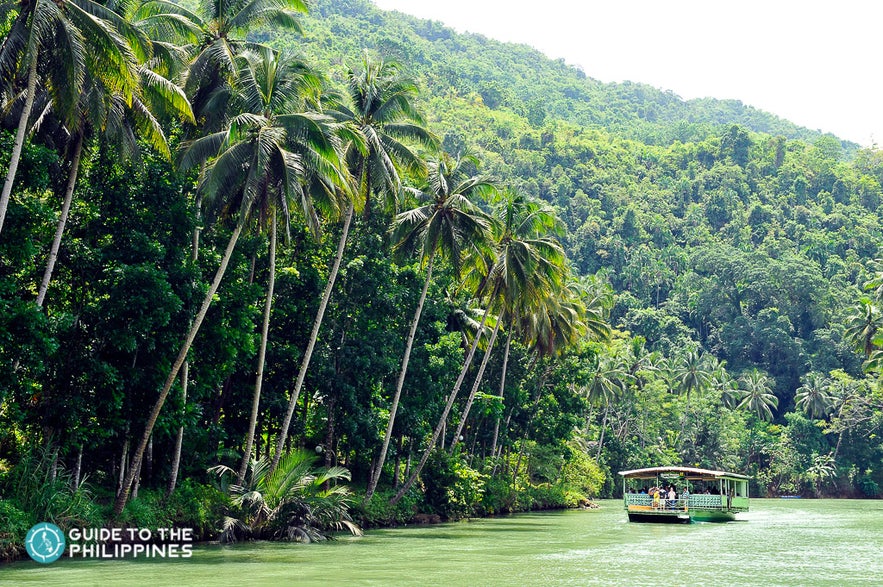
Take a ferry from the island of Cebu to its neighbor Bohol, known for its natural landscapes and historic sites. The Bohol countryside tour is a 1-day adventure that showcases some of the island’s most unique attractions. You can choose to stay overnight in Bohol Island or return to Cebu Island after your tour.
Bohol Countryside Tour Highlights:
-
Chocolate Hills: See over 1,200 symmetrical hills that resemble chocolate mounds during the dry season.
-
Tarsier Sanctuary: Meet the adorable tarsiers, one of the world’s smallest primates.
-
Loboc River Cruise: Enjoy a scenic lunch cruise with live music along the Loboc River.
-
Blood Compact Shrine: Discover the historic symbol of friendship between Filipinos and Spaniards.
-
Baclayon Church: Visit one of the oldest churches in the Philippines.
Day 11: Cebu Province
 You'll have another day in Cebu province to enjoy other activities you we're not able to do here on your Day 9.
You'll have another day in Cebu province to enjoy other activities you we're not able to do here on your Day 9.
Day 12-13: Boracay Island
Fly to Boracay, a world-famous island celebrated for its powdery white sand beaches and vibrant nightlife. Known as the “party island,” Boracay offers a mix of relaxation and adventure.
Venture beyond White Beach on an island-hopping tour to discover Boracay’s hidden gems and scenic beaches.
Things to do in Boracay:
-
Relax on White Beach: Spend time sunbathing, swimming, and enjoying the scenery on Boracay Island’s main beach.
-
Island hopping: Discover hidden coves and beaches on an island-hopping tour around Boracay’s nearby islets.
-
Try fun water activities: Go parasailing, helmet diving, or paraw sailing for an exciting view of Boracay Island’s turquoise waters.
-
Join a sunset cruise: Take in Boracay’s stunning sunsets on a relaxing evening cruise along the coast.
-
Dine along the beach: Explore Boracay’s diverse dining options along White Beach.
-
Experience Boracay’s nightlife: Sip cocktails or dance the night away at a beachfront bar.
Day 14: Return to Manila City
Fly back to Manila City and spend your last day in the bustling capital. Enjoy one last taste of Filipino culture before your journey comes to an end. You can stay here for another night if your flight isn't until the next day.
For a seamless experience, browse expertly-designed 2-week packages in the Philippines to explore these iconic destinations without the hassle of arranging everything yourself.
Frequently Asked Questions about Traveling to the Philippines
Here are some commonly asked questions to help you prepare for an enjoyable and safe journey:
Is it safe to visit the Philippines?
Yes, the Philippines is generally safe for international travelers. As with any destination, stay alert in crowded places, keep valuables secure, and follow local advisories. For added peace of mind, consider getting travel insurance in the Philippines, especially if you plan on joining activities like hiking or diving.
What is the best time to visit the Philippines?
The best time to visit is during the dry season, from November to May, when the weather is ideal for beaches, island hopping, and outdoor activities. The rainy season, from June to October, can bring occasional typhoons, particularly from July to September.
When is the best time to book domestic flights in the Philippines?
For the best fares and seat availability, it's recommended to book domestic flights at least 1 to 2 months in advance, especially if you plan to travel during peak seasons. These include December to May (dry season), Holy Week (usually in March or April), long weekends, and major local festivals. Bookmark this calendar guide on the holidays and festivals in the Philippines to help you plan your trip.
Popular destinations like the islands of Boracay, Palawan, Cebu, Bohol, and Siargao can sell out quickly, so early booking is essential. To simplify your travel planning, you can book your local flights through Guide to the Philippines, which offers flight options alongside tours and packages.
Do I need a visa to visit the Philippines?
Many nationalities can enter the Philippines visa-free for up to 30 days, including citizens of the US, UK, EU, Australia, and ASEAN countries. However, travelers from some countries must apply for a visa in advance. If you book a vacation package with Guide to the Philippines, we can connect you with trusted visa processing partners to assist you.
How can I extend my visa in the Philippines?
If you entered the Philippines on a visa-free stay or a 30-day tourist visa, you can apply for an extension at any Bureau of Immigration office in the country. The first extension usually grants an additional 29 days, and further extensions can be requested for longer stays. It’s recommended to apply at least a week before your visa expires. If you book through Guide to the Philippines, our travel support team can also help connect you with visa extension assistance services.
What are the people of the Philippines called?
Citizens of the Philippines are called Filipinos.
What languages are spoken in the Philippines?
The Philippines has two official languages: Filipino and English. English is widely spoken, especially in cities and tourist areas. There are also over 180 regional languages spoken across the country, such as Cebuano, Ilocano, and Waray.
What’s the best way to get around in the Philippines?
To travel between islands, domestic flights are the fastest and most convenient option. Ferries and boats are also available for shorter routes. In cities, you can get around using taxis, Grab (a ride-hailing app), jeepneys, tricycles, or by booking private transfers in advance.
Can I drive in the Philippines using my foreign driver's license?
Yes, visitors can drive in the Philippines using a valid foreign driver’s license for up to 90 days from their date of arrival, as long as it is in English. If your license is not in English, you will need to carry an official English translation or apply for an International Driving Permit (IDP). After 90 days, you must apply for a local driver's license if you wish to continue driving.
Is WiFi widely available in the Philippines?
Yes, WiFi is commonly available in hotels, restaurants, and cafes in major cities and tourist areas. However, in remote islands or provinces, internet can be slow or limited. It’s a good idea to purchase a local SIM card or an eSIM in the Philippines with mobile data for reliable connectivity.
Can I use my credit card in the Philippines?
Credit cards are accepted in most hotels, malls, and restaurants in major cities and tourist hubs. However, cash is essential when visiting smaller towns or remote islands. ATMs are widely available in cities, but may be limited in rural areas—so plan ahead and carry enough Philippine Pesos.
What is the currency in the Philippines?
The official currency is the Philippine Peso (PHP). You can exchange money at airports, banks, and authorized money changers. It’s best to carry small bills for local transportation and markets. As an alternative, you can also purchase Guide to the Philippines travel e-gift cards to use as a travel fund for booking tours, hotels, and packages online.
What is the time zone in the Philippines?
The Philippines follows Philippine Standard Time (PST), which is UTC+8. It does not observe daylight saving time, so the time remains the same throughout the year. This time zone is the same as Singapore, Malaysia, Hong Kong, Taiwan, and parts of China. Make sure to adjust your watches and devices accordingly when you arrive.
What should I pack for a trip to the Philippines?
Pack light, breathable clothing, swimwear, sunscreen, insect repellent, a reusable water bottle, and comfortable walking shoes. Bring a light jacket if you plan to visit mountain areas. A waterproof dry bag or pouch is useful for island hopping and boat tours. For convenience, pack a universal power adapter and portable power bank. Here's a helpful guide on what to pack for a trip to the Philippines.
What plug type is used in the Philippines, and will I need an adapter?
The Philippines uses plug types A, B, and C, and the standard voltage is 220V with a frequency of 60Hz. Travelers from countries that use 110V (such as the US or Japan) or different plug types may need a universal travel adapter and a voltage converter for certain appliances. Most modern electronics like phone chargers and laptops are dual-voltage, but it’s always best to check your device label.
Can I buy over-the-counter medicine in the Philippines?
Yes, many common over-the-counter (OTC) medicines are available at local pharmacies like Mercury Drug or Watsons. You can find medications for traveler’s diarrhea, headaches, allergies, motion sickness, and insect bites.
If you experience mild health issues related to tap water (which is not recommended for drinking), sand fly bites, or tropical heat, pharmacies can provide solutions such as rehydration salts, antihistamines, and antiseptic creams. If symptoms persist, it’s best to visit a local clinic or hospital.
What is Filipino food like, and what should I try?
Filipino cuisine is a diverse blend of indigenous flavors and international influences, with roots in Spanish, Chinese, Malay, and American cooking. Meals often strike a balance between savory, sweet, sour, and salty.
Popular local dishes include adobo (meat simmered in vinegar, soy sauce, and garlic), sinigang (a sour tamarind-based soup), lechon (crispy roasted whole pig), and kare-kare (a rich peanut sauce stew usually served with oxtail or vegetables).
For dessert, travelers should try halo-halo, a colorful shaved ice treat topped with fruits, sweet beans, and leche flan.
Filipino fast food is also a cultural experience, with local chains like Jollibee serving iconic dishes such as fried chicken and sweet-style spaghetti.
Seafood is abundant, especially in coastal areas, and vegetarian options are becoming more available in popular tourist destinations.
Adventurous eaters can explore local street food like isaw (grilled chicken intestines) or balut (boiled duck embryo), both considered beloved Filipino delicacies.
Are vaccinations required to enter the Philippines?
No mandatory vaccines are required for entry. However, it’s recommended to be up to date on routine vaccinations, including hepatitis A and B, typhoid, tetanus, and rabies if you plan to visit rural areas or do outdoor activities.
Can I book tours and packages in advance?
Yes. You can book island hopping tours, cultural experiences, airport transfers, and vacation packages in advance through Guide to the Philippines, the country’s leading online travel marketplace. Booking early is especially recommended during peak seasons.
For more travel tips, read our travel guides to learn everything you need to plan the best trip to the Philippines!
